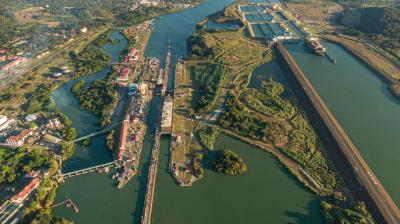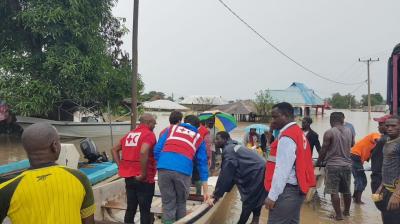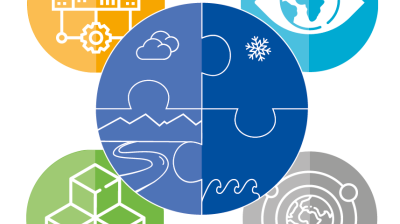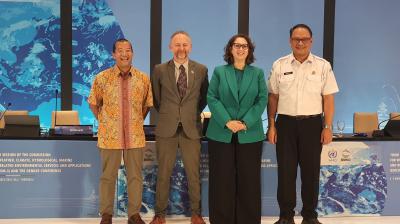Overview of the Early Warnings for All: Executive Action Plan 2023–2027
The delivery of Early Warnings for All in five years requires simultaneous development and implementation of the four essential pillars of Multi-Hazard Early Warning Systems (MHEWS):
- Pillar 1: Disaster risk knowledge
- Pillar 2: Detection, observation, monitoring, analysis and forecasting of hazards
- Pillar 3: Warning dissemination and communication
- Pillar 4: Preparedness and response capabilities
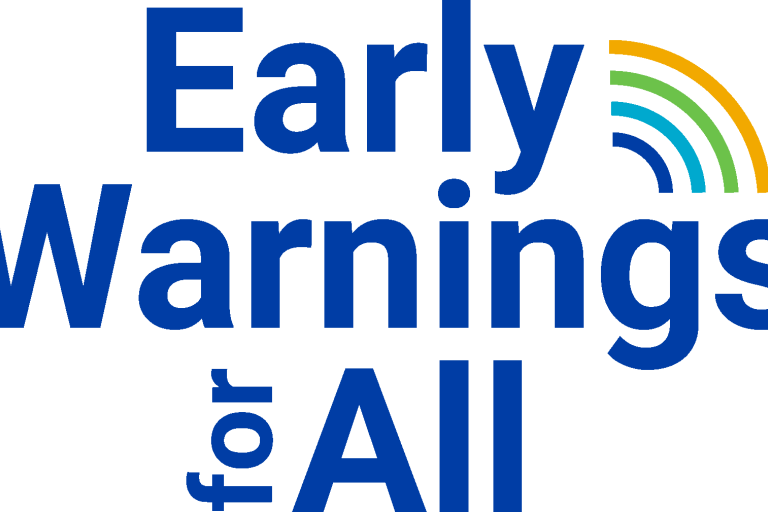
Each of the four Pillars rests on a firm foundation that includes policy implementation, technical investment and skill, and financial support. The Pillars, meshed seamlessly together, deliver reliable, actionable Early Warnings for All. This article provides a brief overview of the Early Warnings for All: Executive Action Plan 2023–2027 to deliver MHEWS in over 100 countries.
Partnerships are essential to the success of the Executive Action Plan. Each Pillar has a lead and supporting organizations (listed below), however, the partnerships are not limited to these entities, the private sector, academia and research institutions have key roles. The Executive Action Plan details priority activities and milestone for every year for each Pillar. Like the ultimate 5-year goal, each year’s targets are ambitious – cooperation and partnerships are the only road to success.
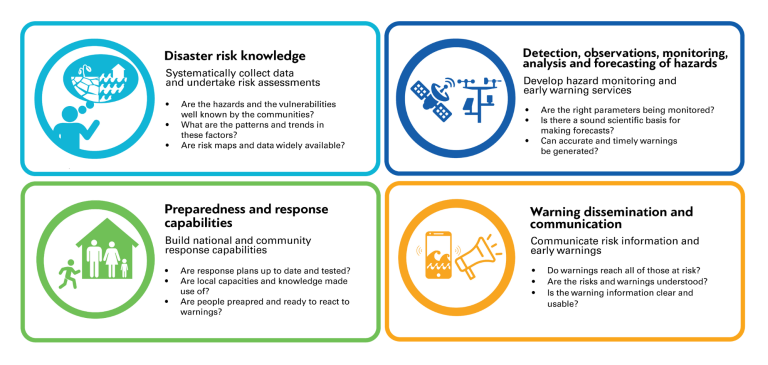
Activities and milestones
Below we highlight some of the Executive Action Plan activities and outcomes for each Pillar by year.
Year One – 2023
Disaster risk knowledge
-
led by the United Nations Office for Disaster Risk Reduction (UNDRR) with support from WMO, within the framework of the joint UNDRR/WMO Centre for Excellence.
Activities:
- Identify gaps in risk knowledge and define the required minimum national and global risk knowledge capability for MHEWSs
- Devise national level plans to fill the capability gaps.
Key outcome:
-
A costing for developing national disaster knowledge over the four years that follow.
Observations and forecasting
-
led by WMO with support from UN Development Programme (UNDP), UN Educational, Scientific and Cultural Organization (UNESCO) and UN Environment Programme (UNEP).
Activities:
- Gap analyses and the cataloguing of hazards will be carried out from 2023–2025.
- Projects planning to address surface observations gaps in 100 countries.
- Phase 1 of activities to improve access to and use of satellite observations and other technologies to enhance detection and forecasting capabilities.
Key outcome:
- Budget notwithstanding, satellite nowcasting facilities will be established in Africa and South America.
Warning dissemination and communication
-
led by the International Telecommunication Union (ITU), with support from International Federation of the Red Cross and Red Crescent (IFRC), the Risk-informed Early Action Partnership (REAP), UNDP and WMO.
Activities
- Develop strategy to clarify roles and responsibilities and the required policy framework for national warning procedures
- Launch projects to strengthen trusted communication channels in 15% of an estimated 140 target countries. Development of an investment model to establish basic Early Warnings for All via cellular telephony. From 2023-2024, co-development of inclusive, multi-sector people-centred approach to create a repository of actionable early warning messages.
Key outcome:
- Launch of projects to enhance existing community-based infrastructure for early warning communication in 15% of target countries.
Preparedness to respond
-
led by IFRC with support from REAP, UN Food and Agriculture Organization (FAO), World Food Programme (WFP) and UN Office for the Coordination of Humanitarian Affairs (OCHA).
Activities aimed at translating early warnings into life-saving action:
- Develop strategy to mainstream preparedness and anticipatory action in national plans, laws and policy
- Launch national training on developing procedures for holistic anticipatory action based on early warnings
- Create a baseline for partnerships at the global, regional and national levels.
Key outcome:
- A 5% increase in the allocation of humanitarian spending for anticipatory action.
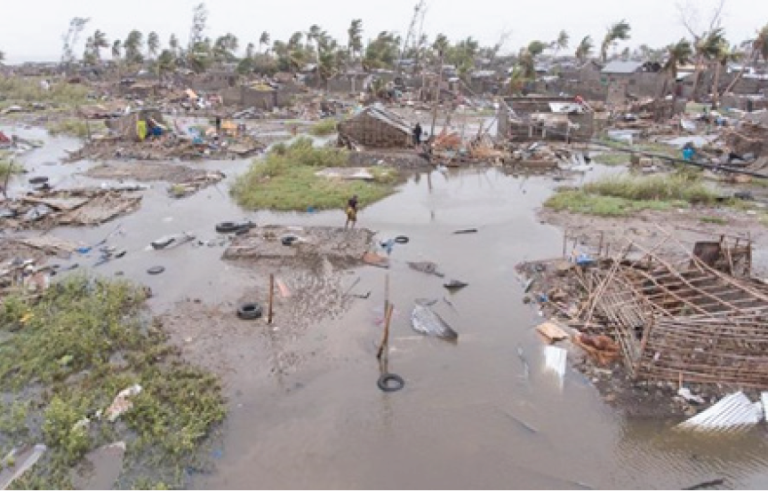
Year two – 2024
Disaster risk knowledge
Activities:
- Minimum risk data and capability will be agreed with target countries over 2024/2025.
- Launch, thereafter, of capacity development projects to improve access and quality of risk data and enhance loss and damage tracking systems in 125 countries from 2024 to 2027.
Observations and forecasting
Activities:
- Start rollout of projects to address surface observations gaps in 100 countries continues.
- Move to Phase 2 of satellite data hub.
Warning dissemination and communication
Key outcomes:
- 25% of target countries have legislation clarifying roles and responsibilities for warning procedures in place
- 40% have adopted a regulatory approach to geo-located early warnings.
- Existing community-based infrastructure strengthened in an additional 75% of countries.
- All countries have satellite distribution backup and agreements for support with regional centres.
Preparedness to respond
Activities:
- Analysis of partnership needs begin.
Key outcome:
- 35 countries have integrated risk-informed actions into national plans, laws and policy.
- 90 countries have strengthened capacity and are developing procedures for holistic anticipatory action based on early warnings.
- Increase the allocation of humanitarian spending for anticipatory action by 10%.
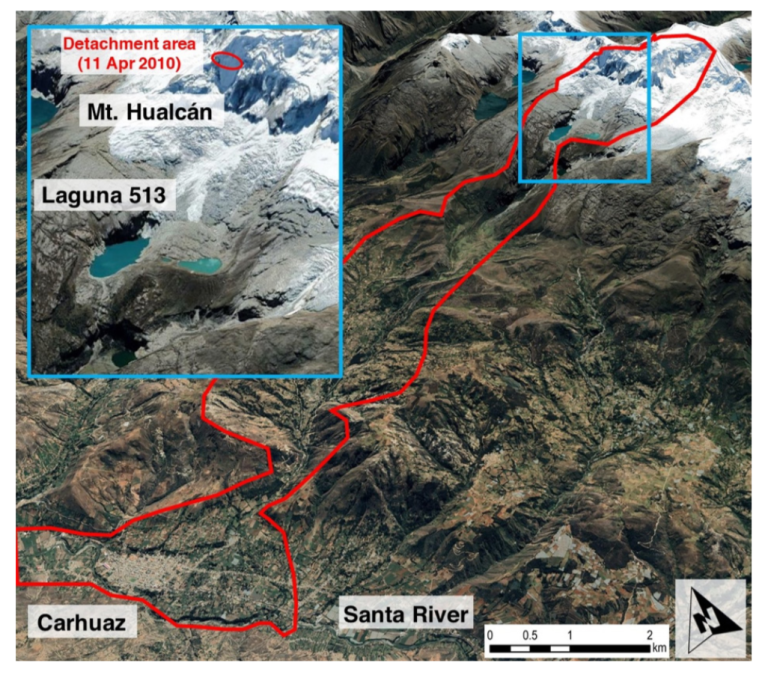
Year three – 2025
Disaster risk knowledge – Continuation from 2024
Observations and forecasting
Activities:
- Continue rollout of projects to address surface observations gaps in 100 countries.
- Launch of Phase 3 of satellite data hub.
Warning dissemination and communication
Activities:
- Redesign of the Register of Alerting Authorities.
Key outcomes:
- 70% of target countries have strengthened trusted communication channels and all have strengthened community-based infrastructure.
Preparedness to respond
Key outcomes:
- 50 countries have integrated risk-informed actions into national plans, laws and policy.
- 100 countries have strengthened capacity and are developing procedures for holistic anticipatory action based on early warnings and have also established the needed partnerships and collaborations.
- The allocation of humanitarian spending for anticipatory action extended to cover one billion people.
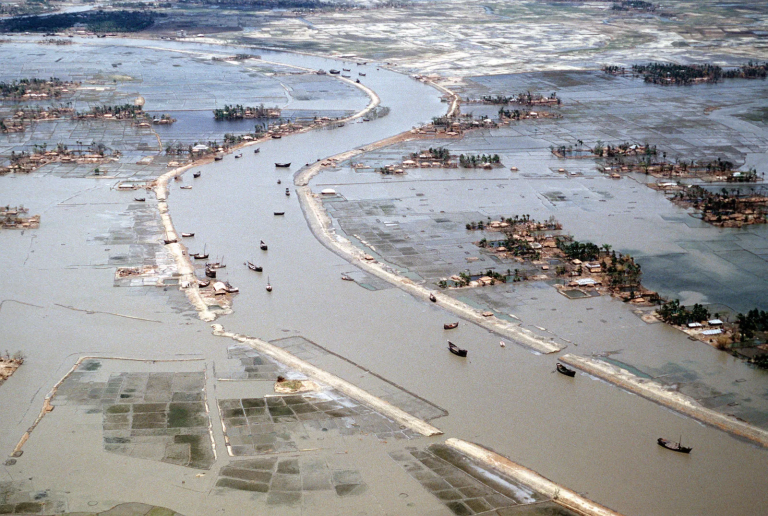
Year four – 2026
Disaster risk knowledge
Key outcome:
- 80% of countries will have achieved minimum risk knowledge capability.
Observations and forecasting
Activities:
- Continue rollout of projects...
- Launch of Phase 4 of satellite data hub.
Warning dissemination and communication
Key outcomes:
- 75% of target countries have legislation clarifying roles and responsibilities for warning procedures.
- Develop Artificial Intelligence tools to support the scaling up of actionable alerts.
Preparedness to respond
Key outcomes:
- 75 countries have integrated risk-informed actions into national plans, laws and policy.
- 110 countries have strengthened capacity and are developing procedures for holistic anticipatory action based on early warnings and have also established the needed partnerships and collaborations.
- Increased the allocation of humanitarian spending for anticipatory action by 15%.
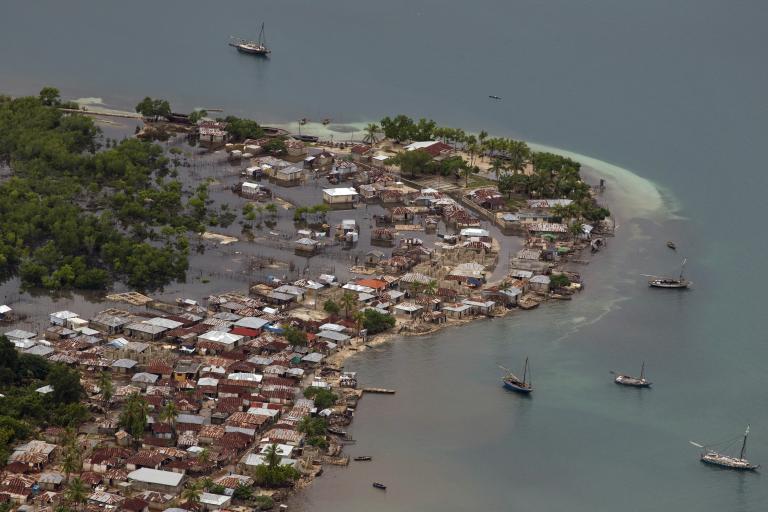
Hurricane Sandy in 2012 caused heavy rains and strong winds, overflowing rivers and flooding homes off the West Coast of Haiti (Source: UN Photo/Logan Abassi)
Year five – 2027
Disaster risk knowledge
Key outcomes: 100% of countries will have achieved the minimum risk knowledge capability.
Observations and forecasting:
Activities:
- Wrap-up of final surface observations gap projects.
- Phase 5 of satellite data hub.
Warning dissemination and communication
Key outcomes:
- 100% of target countries have legislation clarifying roles and responsibilities for warning procedures, have geo-located basic cellular telephony early warning systems and strengthened trusted communication channels.
- All countries have actionable Common Alerting Protocol (CAP) early warnings.
Preparedness to respond
Key outcomes:
- 100 countries have integrated risk-informed actions into national plans, laws and policy.
- 125 countries have strengthened capacity and are developing procedures for holistic anticipatory action based on early warnings and have also established the needed partnerships and collaborations. Increase the allocation of humanitarian spending for anticipatory action by 20%.
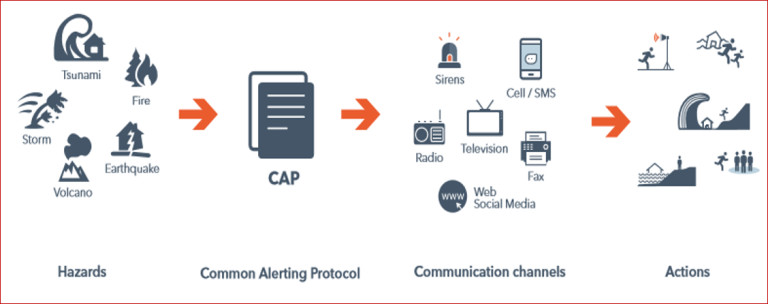
Scaling-up Finance
Based on the estimates of the lead agencies and partners, new investments of US$ 3.1 billion will be required over the five years to deliver on the Early Warnings for All: Executive Action Plan:
- US$ 374 million for Disaster risk knowledge
- US$ 1.19 billion for Observations and forecasting
- US$ 550 million for Warning dissemination and communication
- US$ 1 billion for Preparedness
This US$ 3.1 billion investment represent approximately 6% of the total global adaptation financing which has been called for annually (US$ 50 billion). The required up-front financing is modest compared to the return in investment to protect lives and property.
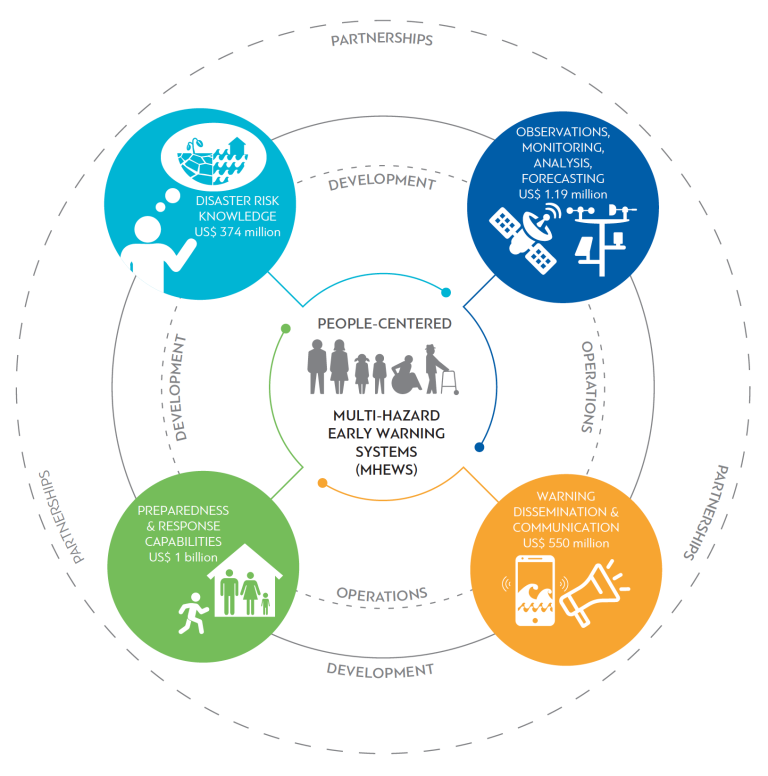
The Executive Action Plan focuses on ensuring concrete implementation on-the-ground to make a difference and on securing sustainable financing of foundational elements to ensure rapid progress over the next five years. Financing will be balanced across the four components in an inclusive manner and financing by development partners will be tracked to improve effectiveness.
The challenge is to ensure a coordinated approach and to scaling-up targeted financial instruments such as the Systematic Observation Financing Facility (SOFF) and the Climate Risk and Early Warning Systems (CREWS) initiative. Further mobilization of financial partners, including the World Bank, Climate Investment Fund (CIF) and regional development banks, is also critical to raise the rate of financing for people-centred, risk-informed approaches to early warnings and action.
Governance and monitoring
United Nations Secretary-General is creating an Early Warnings for All High-Level Advisory Panel, co-chaired by the executive heads of WMO and UNDRRR, to ensure sound governance and monitor implementation towards achieving the five-year goal. Members will include the lead agencies, a representation of implementing partners, financing entities and the United Nations Climate Action Team, who will represent the Secretary-General. The Board will meet twice annually and report on progress towards achieving the goals set for each component as well as towards achieving the required levels of financial mobilization.
In addition, an annual Multi-Stakeholder Forum will be organized to enhance consultation with a wider group of partners – from UN agencies, hydrometeorological services, early action coordinators, financial institutions, academia, civil society, the private and disaster sectors. These stakeholders will also be invited to contribute over the coming months to the development of the Early Warnings for All Maturity Index.
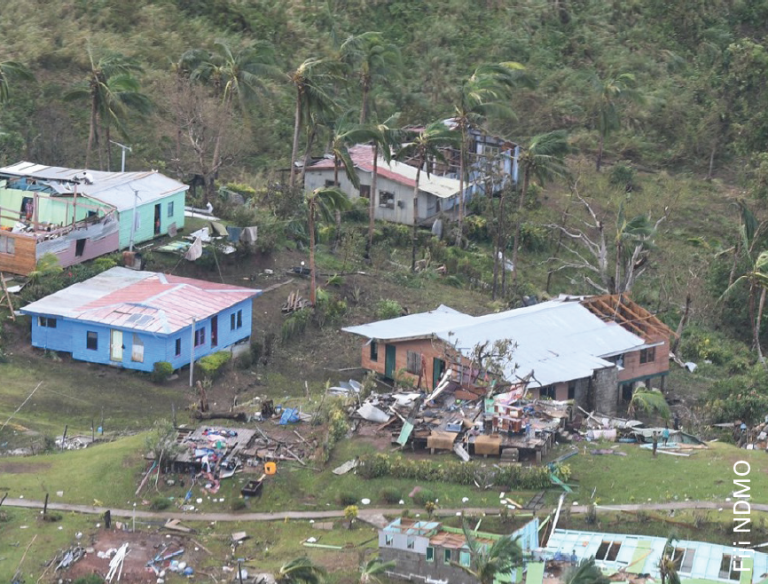
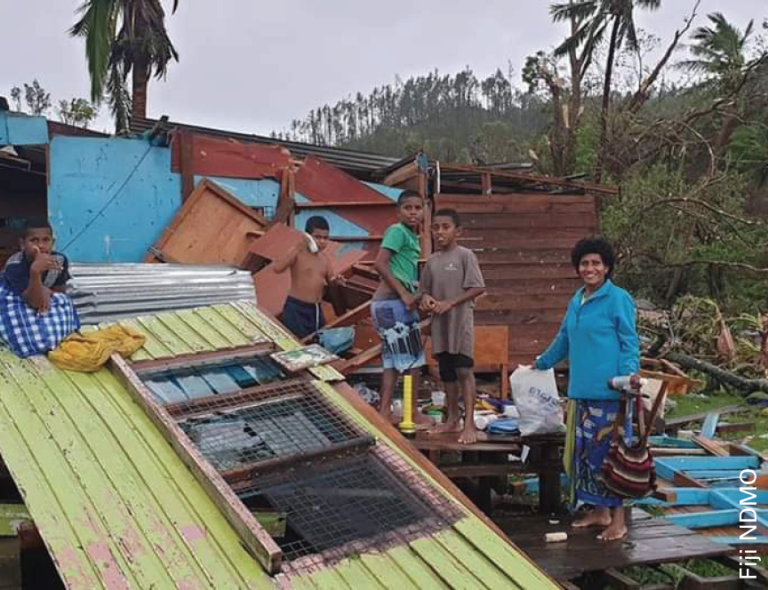
Following Tropical Cyclone Harold in April 2020, Fijian Prime Minister Frank Bainimarama stated: “The increasing ferocity of tropical cyclones due to climate change presents the greatest ever threat to Fiji's development.” Worldwide over the past 50 years 1 942 disasters have been attributed to tropical cyclones, which killed 779 324 people and caused US$ 1 407.6 billion in economic losses – an average of 43 deaths and US$ 78 million in damages every day.
Solutions
At the launch of the Early Warnings for All: Executive Action Plan at the UN Climate Conference in Egypt (November 2022), many in the public, private, academic, financial, governmental, non-governmental and inter-governmental sectors expressed interest in contributing to the Early Warning for All implementation over the next five years. We encourage them to peruse the Executive Action Plan and to contact WMO and the partners leading each of the Pillars with solutions or proposals specifying in which area, where and how they can contribute over the coming five years.
Integrating the water and climate agendas
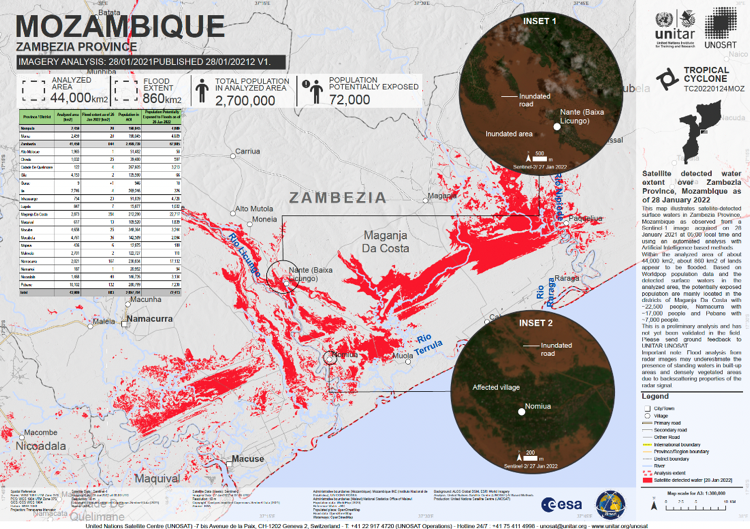
Water is the primary vehicle through which we feel the threats of climate change. An IPCC report in 2022 highlighted that climate change would at least double the risks to populations exposed to floods and droughts. Effective end-to-end early warning systems for floods, droughts and water-related hazards are urgently needed.
Gaps in water and climate data at the local, national and regional levels urgently need to be addressed as well as the lack of forecasting capability, good governance, proper communication and preparedness at the grass-root level. More and better-quality data needs to be accessible to all on all time and geographical scales to benefit all.
Some 100 countries require implementation of end-to-end early warning systems for floods, droughts and water-related hazards in a minimum of 100 countries.




